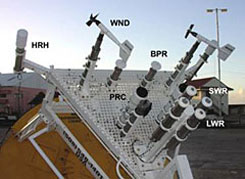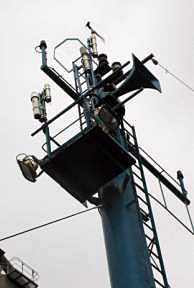| ASIMET Modules |
 |
| Close-up of ASIMET modules on tower of three-meter discus buoy. |
| VOS Columbus Florida |
 |
| Close-up of VOS Columbus Florida bow-mast with first-generation ASIMET modules installed. |
The Air-Sea Interaction METeorology (ASIMET) System
Technical documentation relating to buoy-mounted and shipboard ASIMET sensors is available from the WHOI Design Group for Electronics (DGE) Web page.
The Air-Sea Interaction Meteorology (ASIMET) system is a suite of meteorological and sea surface sensors that are deployed with different housings and packaging depending on the application. ASIMET modules (one or more sensors plus front-end electronics) may be self-powered and self-logging, connected to a central power supply and logger, or both. Together, these modules measure Air temperature (AT), specific humidity (SH), sea surface temperature and conductivity (SST, SSC), wind speed and direction (WSPD, WDIR), barometric pressure (BP), shortwave radiation (SWR), longwave radiation (LWR), and precipitation (PRC). These variables are used to compute air-sea fluxes of heat, moisture and momentum using bulk aerodynamic formulas.
On buoys, modules are packaged in titanium cylinders that include provisions for batteries and internal logging. Buoy modules are typically deployed in pairs, with 6 meteorological module pairs mounted on the buoy tower and a pair of temperature-conductivity sensors attached to the bridle leg. A central logger records one minute data from all the modules on a common time base, and also creates hourly averaged data that are transmitted to shore via Argos satellite telemetry.
On ships, the same sensors and electronics are used for all of
the variables except SST, but with different packaging. The wind
module is in a titanium housing like that used on buoys, but without
an internal compass. Sensors for RH, AT, SWR, LWR and PRC are
packaged together in a splash-proof fiberglass box. The BP sensor
is in a second fiberglass box that also houses the central logger.
All of these sensors are mounted on the ship’s bow mast.
Power comes from a battery canister at the base of the mast. SST
is an inside-hull mounted sensor placed just below the waterline
of the ship (with magnets) that uses the ships hull as an acoustic
path for sending data to the bow mast (SSC is not measured). Data
are recorded once per minute in the logger, and a subset is sent
by radio to the bridge every 6 minutes. The NOAA SEAS (Shipboard
Environmental (Data) Acquisition System) incorporates these data
into automated hourly weather reports from the ship to the National
Weather Service.
See instructions
on reading internally-stored flash card data.
Last updated: October 25, 2016

